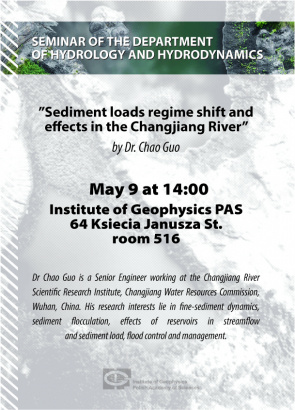Seminar of the Department of Hydrology and Hydrodynamics "Sediment loads regime shift and effetcs in the Changjiang River"
We cordially invite you to a scientific seminar organized by the Department of Hydrology and Hydrodynamics, which will take place at the Institute of Geophysics of the Polish Academy of Sciences on May 9 at 14:00 at the Institute of Geophysics of the Polish Academy of Sciences, ul. Ksią Janusza 64, room 516. Seminar entitled "Sediment loads regime shift and effects in the Changjiang River" will be led by Dr. Chao Guo of the Yangtze River Scientific Research Institute.
Dr Chao Guo is a Senior Engineer working at the Changjiang River Scientific Research Institute, Changjiang Water Resources Commission, Wuhan, China. His research interests lie in fine-sediment dynamics, sediment flocculation, effects of reservoirs in streamflow and sediment load, flood control and management.
Abstract
Sediment loads regime shift and effetcs in the Changjiang River
Sediment transport from rivers to oceans is of primary importance in global geochemical cycle. Many large rivers in the world, in particular in the global hydrologic north, deliver decreasing sediment loads to coastal oceans owing to reductions in sediment yield and disrupted sediment deliver. As one of the world’s largest river systems, the Changjiang River (CR) basin (mainstem length of ~6400 km, and drainage area of ~1.9 million km2, and annual streamflow of ~900 billion m3) has occurred marked sediment loads regime shift in the past a few decades, mainly due to the constructions of Three Gorges Dam (TGD) and a series of other hydropower dams. The sediment loads have decreased progressively throughout the basin with ~90% and ~70% at the outlets of the upper basin and entire basin, respectively. The upper reach of CR has shifted from sediment source to sink zone (including very fine sediment), while the middle-lower river has changed from a slight depositional to a severe erosional environment. Moreover, these low-level sediment loads will likely persist in the future considering the cumulative dam trapping and depleted channel erosion. As a result, substantial changes of sediment and adherent nutrients fluxes, river morphology have occurred that affect the water supply, flood mitigation, and the aquatic ecosystem etc. in the CR basin. The studies and lessons in the CR can shed light on other river systems subject to intensified human interference.






















